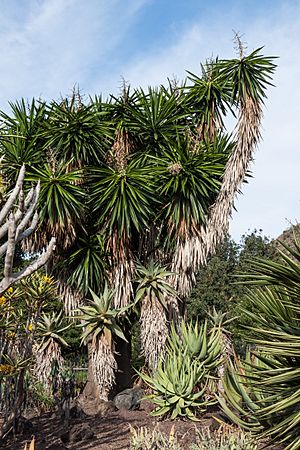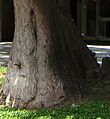Yucca gigantea facts for kids
Quick facts for kids Yucca gigantea |
|
|---|---|
 |
|
| Scientific classification |
The Yucca gigantea (also known as Yucca elephantipes) is a type of flowering plant in the asparagus family. It comes from Mexico and Central America. This plant can grow very tall, up to 8 to 12 meters (26 to 39 feet). It's an evergreen shrub, meaning it stays green all year round. People often grow it in gardens or as a houseplant, and sometimes just call it "yucca cane."
The flower of this plant is special because it's the national flower of El Salvador. There, people call it izote. The flowers are also used a lot in cooking in El Salvador.
Contents
What it's Called
This plant has many common names! Some of them are spineless yucca, soft-tip yucca, blue-stem yucca, giant yucca, yucca cane, and itabo.
As mentioned, its flower, the izote, is the national flower of El Salvador.
What it Looks Like
Yucca gigantea usually grows less than 6 meters (20 feet) tall. It might have one thick trunk or several trunks. The bottom part of the trunk can be wide and swollen, looking a bit like an elephant's foot. This is why it sometimes gets the name elephantipes.
Its leaves are long and narrow, like straps, and they don't have spines. They can be up to 1.2 meters (4 feet) long and fan out in groups. In the summer, white flowers appear. Older plants grow tall spikes, up to 1 meter (3 feet 3 inches) long, with hanging flowers. After the flowers, brown, soft fruits grow. These fruits are oval and about 2.5 centimeters (1 inch) long.
How it Got its Name
A French plant expert named Charles Antoine Lemaire first gave this plant the name Yucca gigantea in 1859. This is the name used by most plant lists today.
However, you might also hear it called Yucca elephantipes. This name was first mentioned by a German plant expert, Eduard August von Regel, in 1859. He noticed that another yucca, Y. aloifolia, was sometimes called Y. elephantipes in gardens because of its thick stem base. But he didn't mean for it to be the official name for Yucca gigantea. Later, in 1902, an American plant expert named William Trelease also used the name Y. elephantipes. But by then, Yucca gigantea was already the accepted name. So, Y. elephantipes is not the official scientific name, even though it's still very common in gardening books.
Where it Grows
Yucca gigantea naturally grows in several countries in Central America, including Belize, Costa Rica, El Salvador, Guatemala, Honduras, and Nicaragua. It's also found in the eastern part of Mexico.
You can also find it growing wild in places like Puerto Rico, the Leeward Islands, and Ecuador, where it has spread from cultivation.
How to Grow it
This plant can grow in different types of soil and doesn't need a lot of water. Young Yucca gigantea plants are sometimes kept as houseplants. However, they grow best in warm, dry places. If you give them too much water, especially older plants, their roots can rot. Younger, smaller plants are often better for indoors because they can handle changes in their environment more easily.
Yucca gigantea can handle some cold weather, but it's not as tough as other yucca plants from colder desert areas. Like many plants, it can get pests such as scale insects, yucca moth borers, and yucca weevils. Sometimes, its leaves might get spots, but this usually doesn't hurt the plant's health. You can grow new plants from small shoots that grow from the base, from cuttings, or from seeds.
Because it's a great garden plant, the Yucca gigantea (under its common name Yucca elephantipes) has won an Award of Garden Merit from the Royal Horticultural Society.
Uses
The flower petals of Yucca gigantea are often eaten in Central America. Before cooking, people remove the bitter parts of the flower, like the anthers and ovaries.
The petals are often boiled for about 5 minutes. Then, they can be cooked "a la mexicana" (with tomato, onion, and chili) or made into egg-battered patties with green or red sauce. In Guatemala, people boil the petals and eat them with lemon juice.
In El Salvador, people also eat the tender tips of the stems. They call these "cogollo de izote."
Gallery
-
Izote, the national flower of El Salvador
-
Young Yucca gigantea and Aloe vera kept as a houseplant
See also
 In Spanish: Yuca pie de elefante para niños
In Spanish: Yuca pie de elefante para niños





